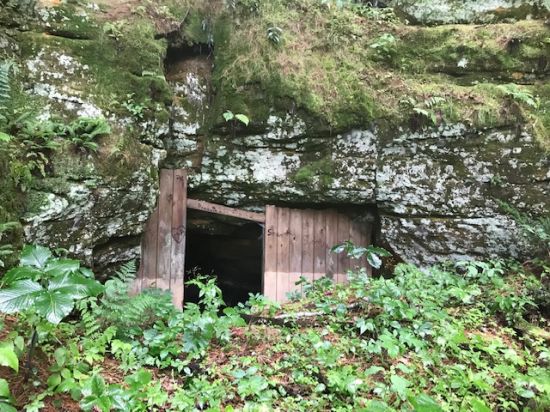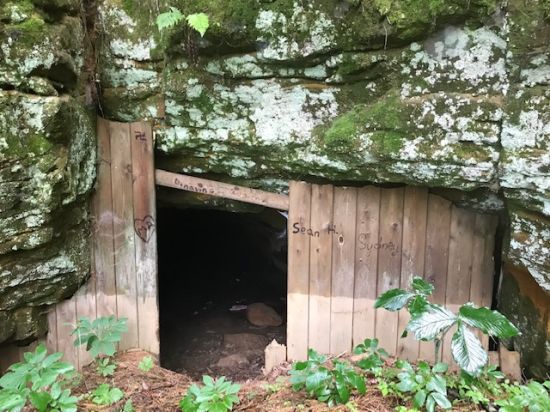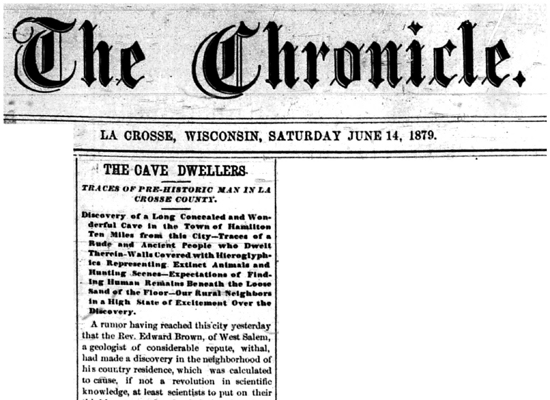
A One-of-a-kind Cave in La Crosse County
(written by Carla Swerman, Archives staff)
This blog is one-of-a-kind in the Archives Department’s “cave” of local history stories. First, its content pre-dates the other blogs in that it goes back to the time of early Native Americans. Secondly, this blog is purposefully vague in that it does not reveal identifying factors that could lead to additional destruction of a one-of-a-kind historic site, a cave in La Crosse County.
“Pictured Cave” was discovered in October of 1878 when an 18-year-old named Frank was raccoon hunting on the family farm. As he was setting a trap, he spotted a narrow hole in a hill. Frank managed to crawl through the hole dug by wild animals. Later, he and a few others got lanterns and explored the cave. The walls were covered with pre-historic pictures and charcoal paintings, hence the cave’s name. Others soon heard of the Pictured Cave and were building fires inside and carving their own names and pictures on the walls.

This photo shows the Pictured Cave as it appears when approaching it. The cave is not easy to spot since it is heavily surrounded by foliage. (Photo by Carla Swerman, 2 July 2019)

Signs of graffiti as well as the property owner’s attempt to barricade the cave are evident when approaching the 15-foot wide cave opening. (Photo by Carla Swerman, 2 July 2019)
By the following summer, the Rev. Edward Brown, a pastor and geologist in West Salem, had heard of the Pictured Cave. Around June 1, 1879, he visited the cave and quickly realized its archaeological value. By studying the nearby tree growth, he surmised that a landslide from about 150 years prior had significantly narrowed the opening in the cliff and had also filled half the cavern with sand.
So, Brown talked to Frank’s father, who immediately built what was supposed to be a secure door to stop the vandalism that had already occurred. He also enlarged the cave opening to its original 15 feet and cleared out the sand from the landslide. Now, the cave was about 13 feet high, 30 feet long, and 16 feet at its widest.
About the same time, Brown used black crayon to trace the carvings and pictures on tissue paper. He made more than 45 facsimiles, a handful of which were published in the June 14, 1879, issue of The (La Crosse) Chronicle.

Rumors of the Pictured Cave were now legitimized with this front page article.

Brown perceived this to be a mastodon; the editor of the article questioned that perception.

According to Brown, this represents a chief. The lower portion of the right arm, the right leg, and the left foot are missing, however. The article accounts for this by explaining that scaled-off rock in those spots had left a smooth surface.

This may be the clearest depiction - it shows a boy behind a hunter who is using a bow and arrow to kill an animal.
The secretary of the Wisconsin State Historical Society saw the article in The Chronicle and sent Dr. J.A. Rice, an archaeologist, from Merton in Waukesha County to assist Brown with excavating the cave. In fact, on June 27, 1879, seventeen men used shovels and wheelbarrows to explore the Pictured Cave.
They unearthed four layers of ashes, each four to six inches deep with ten to fourteen inches of sand between them. The top layer contained bones of birds and small animals. A seven-inch elk bone that was perfectly preserved was found in the second layer along with pottery made from Mississippi River bivalve shells. The third layer contained less ornate pottery made of clay and ground shells. There was nothing inside the lowest layer of ashes. At the very bottom was water, which was at the same level as a marsh near the cave.
This stratification led the scientists to conclude that the cave was occupied during four different time periods with considerable intervals of vacancy between each. The first occupancy occurred in ancient times and the most recent occurred more than 150 years ago. Rice concluded that the rock art was from the third or fourth period of occupation based upon its height on the cave wall. He affirmed that these petroglyphs (carvings on stone) and pictographs (paintings on stone with natural pigments) were indeed of Native American origin, more specifically of the Sioux nation, and were 400 to 900 years old.
Fortunately, Brown’s careful tracings of the rock art are still housed in the Wisconsin State Historical Society’s Archives and Research Division in Madison. In a 1988 La Crosse Tribune article, James Gallagher, a former UW-La Crosse archaeologist and executive director of the Mississippi Valley Archaeology Center (MVAC), reported that there are only three or four places in Wisconsin that have preserved prehistoric paintings. What became of the artifacts that were removed by the seventeen men is not known. Yet, the pottery that Brown found was made with pieces of ground up shell from mussels, which was characteristic of the Oneata who resided in the La Crosse area from 1200 to 1600 A.D. For that reason, Gallagher concluded that the cave may have served as winter shelter for some Oneata.
Signs of the Oneata were preserved in the Pictured Cave for centuries, due to the landslide. But, once the cave was opened, moisture and temperature changes led to erosion and disintegration of the soft sandstone. Nature and time are not the only culprits in the demise of the Pictured Cave. Since the time of its discovery, man has destroyed the cave’s priceless history with fires, trash, parties, vandalism, etc.

This is what the Pictured Cave’s opening looks like today. (Photo by Carla Swerman, 2 July 2019)
Still, some rock art remains inside the Pictured Cave. In 1986, a crew from the MVAC scoured the walls and spotted about a dozen intact carvings and even discovered a panel of black drawings that had not been documented by Brown. At the time, the Pictured Cave was nominated to the National Register of Historic Places and earned that designation in 1991.
Yet, the damage continues. In 1995, the National Trust for Historic Preservation provided a grant to pay for an insulated wooden gate at the entrance. That door was smashed by vandals in 2001. Fortunately, as MVAC archaeologist Robert F. “Ernie” Boszhardt wrote in his 2016 book, In Hidden Thunder: Rock Art of the Upper Midwest: “The current owners have served as excellent stewards for the site, and for the first time since its discovery, the cave is not being visited and vandalized on a regular basis.”
Throughout its long history, the Pictured Cave has been privately owned. It is undoubtedly one of the oldest archaeological sites in the state and one of a few that contains – and still contains – both petroglyphs and pictographs. In addition, Rev. Brown’s efforts began the study of rock art in Wisconsin. That’s a lot of fame! That fame is why this one-of-a-kind cave’s identity needs to be kept closed from the curious.
For those who are curious, the La Crosse Public Library Archives has more information on the Pictured Cave and on rock art. Learning more would not jeopardize the cave’s current condition. However, visiting the cave without the property owner’s permission would be considered trespassing. So, please head to the second floor of the Library at 800 Main St. instead of “scouting out” the county for this one-of-a-kind cave.

